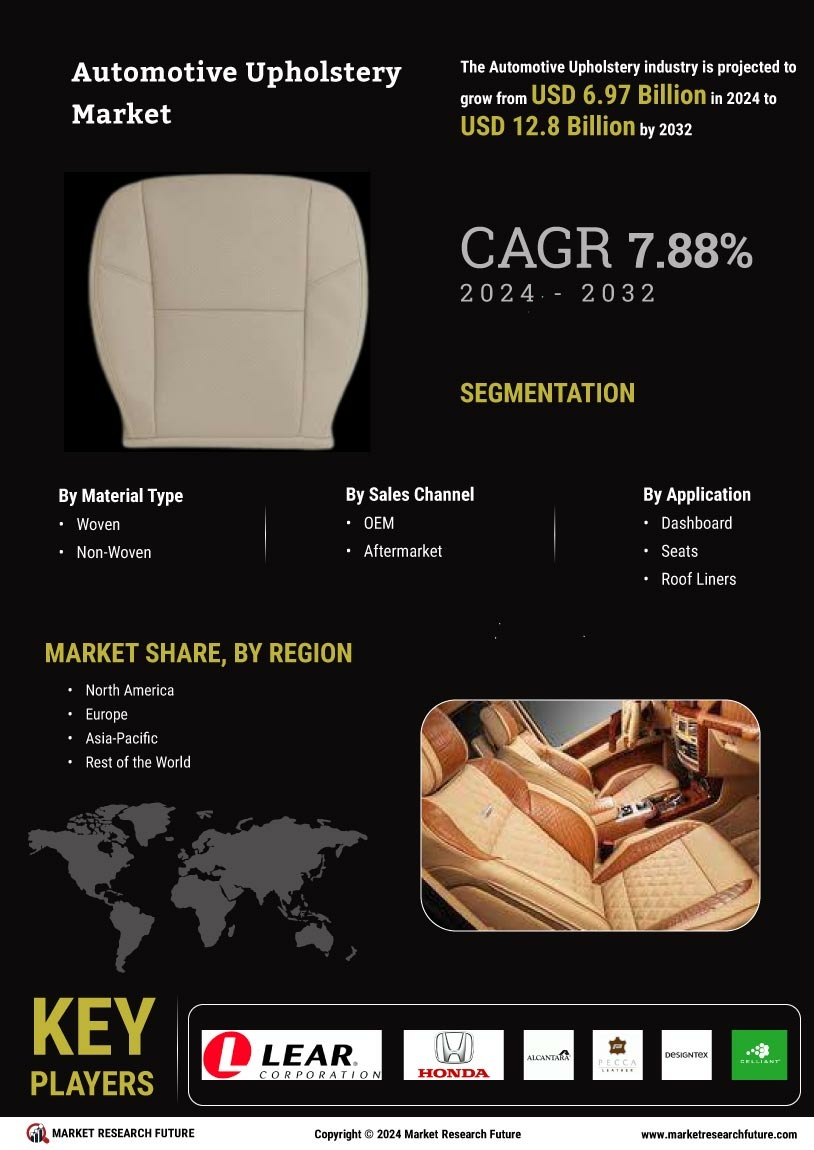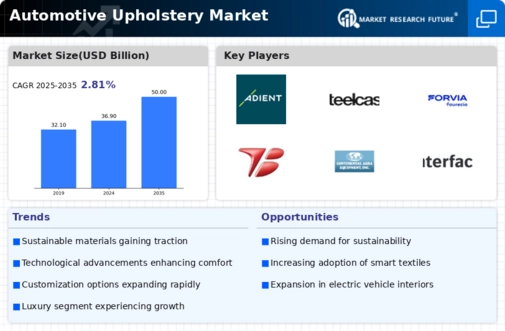Rising Demand for Electric Vehicles
The increasing adoption of electric vehicles (EVs) is a pivotal driver for the Automotive Upholstery Market. As manufacturers pivot towards sustainable and eco-friendly solutions, the demand for innovative upholstery materials that align with the ethos of EVs is surging. In 2025, it is estimated that the EV market will account for approximately 30% of total vehicle sales, necessitating a shift in upholstery design and materials. This transition not only emphasizes lightweight materials to enhance vehicle efficiency but also promotes the use of recycled and sustainable fabrics. Consequently, upholstery manufacturers are likely to innovate and adapt their offerings to meet the evolving preferences of environmentally conscious consumers, thereby propelling growth in the Automotive Upholstery Market.
Growth of the Automotive Aftermarket
The expansion of the automotive aftermarket is a significant driver for the Automotive Upholstery Market. As vehicle owners seek to personalize and enhance their vehicles, the demand for aftermarket upholstery products is on the rise. This segment is projected to grow at a compound annual growth rate (CAGR) of approximately 4% over the next five years. Factors such as increased vehicle ownership and a growing trend towards customization are fueling this growth. Upholstery manufacturers are responding by offering a wider range of products, including custom-fit seat covers and interior accessories. This trend not only enhances consumer choice but also stimulates competition within the Automotive Upholstery Market.
Consumer Preference for Luxury Interiors
The growing consumer preference for luxury and premium vehicle interiors is a notable driver for the Automotive Upholstery Market. As disposable incomes rise, consumers are increasingly willing to invest in high-quality materials that enhance the aesthetic and tactile experience of their vehicles. This trend is reflected in the increasing sales of luxury vehicles, which have shown a steady growth rate of around 5% annually. Upholstery options such as leather, suede, and high-end synthetic materials are becoming more sought after, prompting manufacturers to diversify their product offerings. This shift towards luxury is likely to stimulate innovation in upholstery design, thereby driving growth in the Automotive Upholstery Market.
Technological Advancements in Manufacturing
Technological advancements in manufacturing processes are significantly influencing the Automotive Upholstery Market. Innovations such as 3D printing and automated cutting technologies are streamlining production, reducing waste, and enhancing precision in upholstery design. These advancements allow manufacturers to create intricate patterns and textures that were previously unattainable, thus appealing to a broader range of consumer preferences. Furthermore, the integration of smart textiles, which can respond to environmental changes, is gaining traction. As the market evolves, it is anticipated that these technologies will not only improve efficiency but also elevate the overall quality of automotive upholstery, making it a key driver in the Automotive Upholstery Market.
Regulatory Standards for Vehicle Safety and Emissions
Regulatory standards concerning vehicle safety and emissions are shaping the Automotive Upholstery Market. Governments worldwide are implementing stringent regulations that require manufacturers to utilize materials that are not only safe but also environmentally friendly. This has led to an increased focus on the development of non-toxic, flame-retardant, and recyclable upholstery materials. As a result, manufacturers are compelled to innovate and comply with these regulations, which may lead to the introduction of new materials and technologies in the market. The ongoing evolution of these standards is likely to create opportunities for growth and differentiation within the Automotive Upholstery Market.


















Leave a Comment